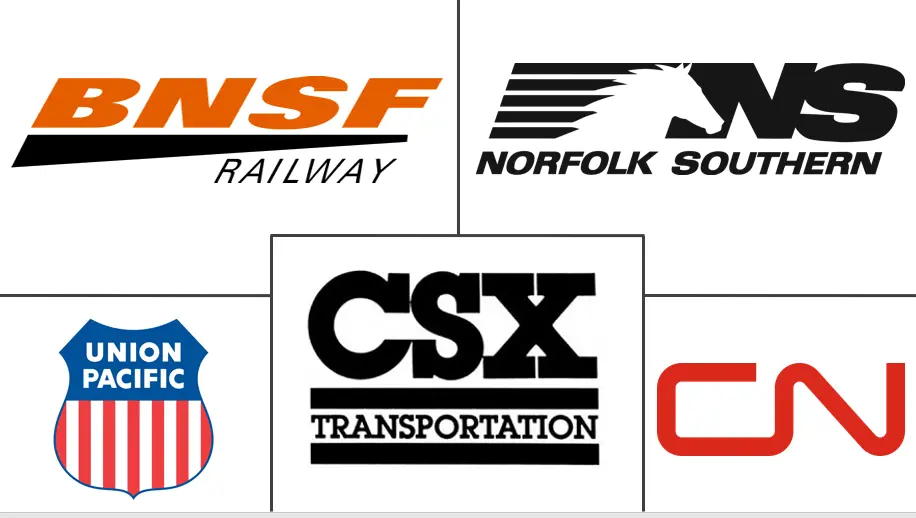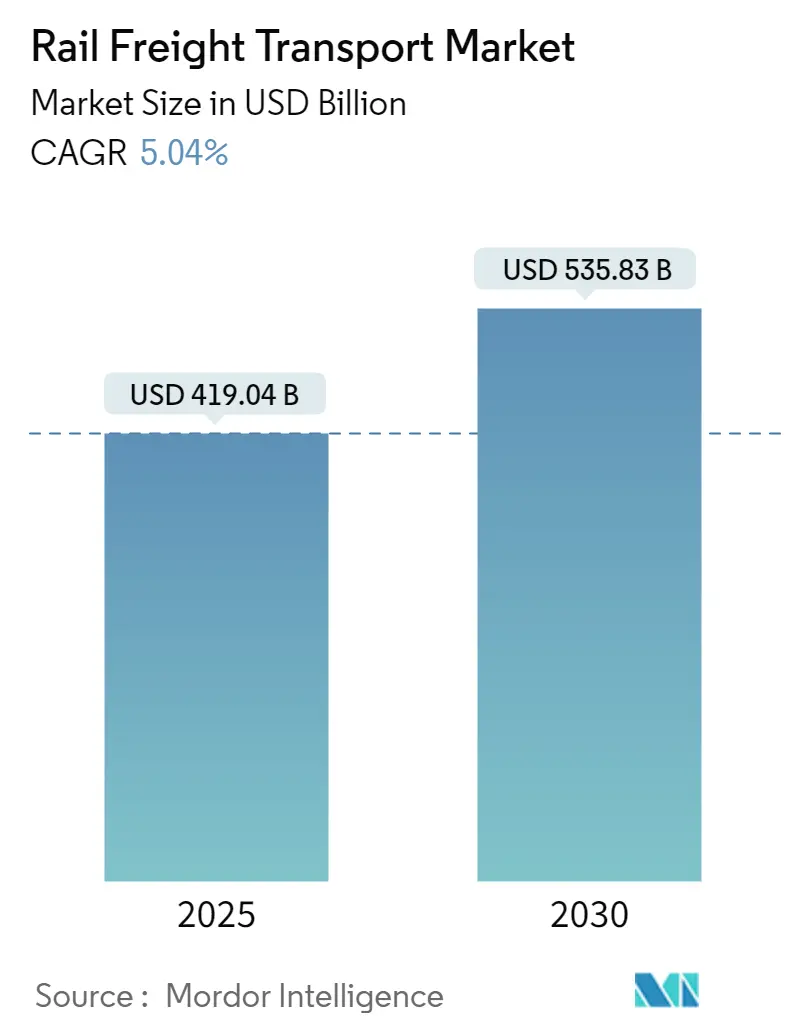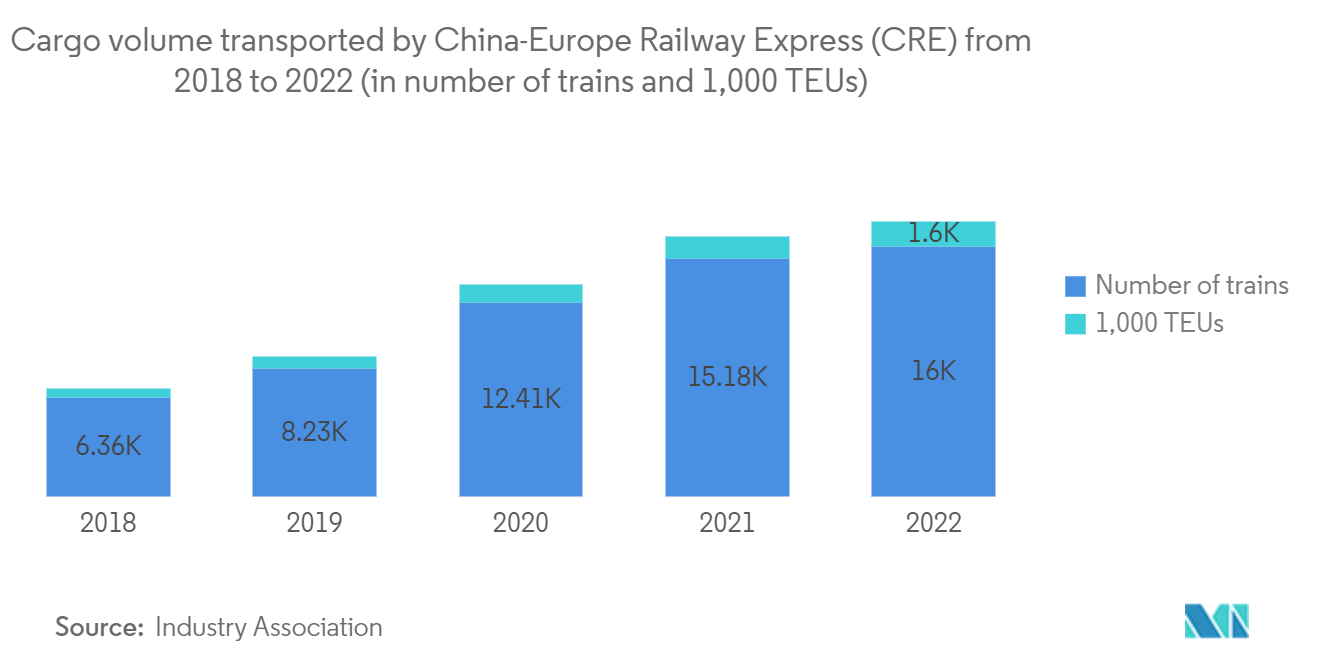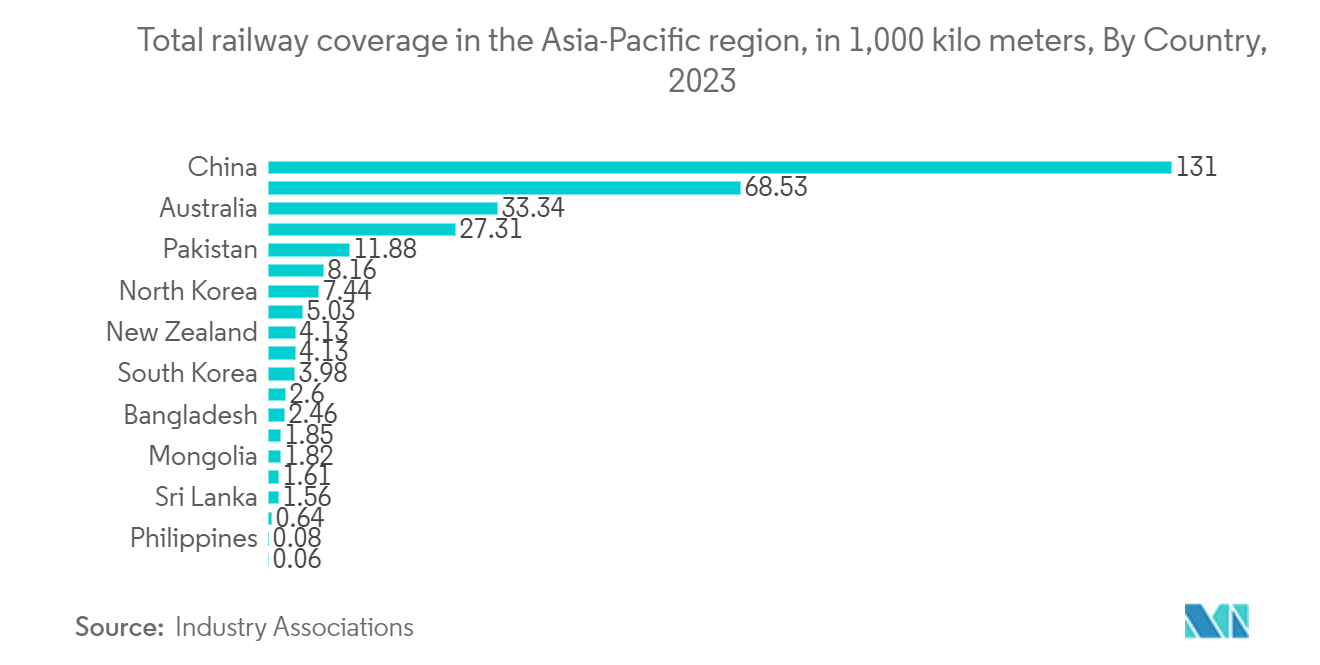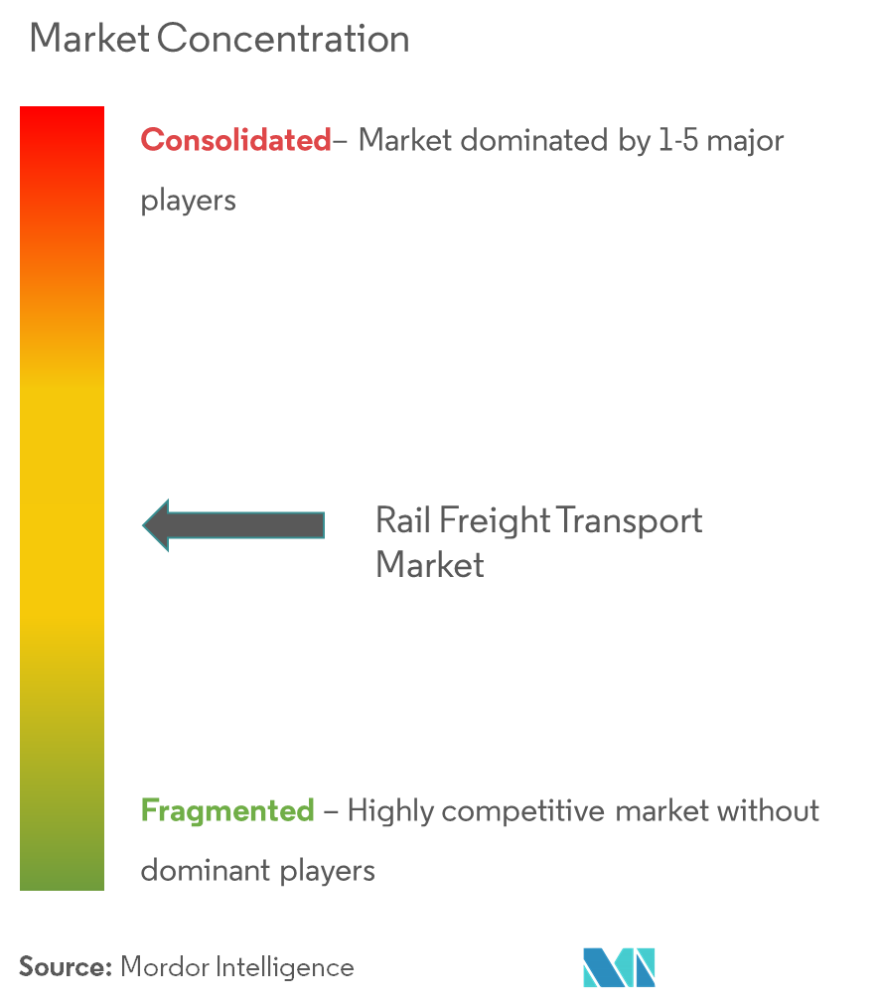Rail Freight Transportation Market Analysis
The Rail Freight Transport Market size is estimated at USD 419.04 billion in 2025, and is expected to reach USD 535.83 billion by 2030, at a CAGR of 5.04% during the forecast period (2025-2030).
Intermodal transportation, which involves the use of multiple modes of transportation (e.g., rail and truck), has been gaining popularity. Railroads play a key role in intermodal logistics, offering an efficient and cost-effective solution for moving freight over long distance. Several significant factors, such as the growth of the world's population and continued urbanization, which contribute to an increasing demand for rail freight services, strongly influence market growth.
Artificial intelligence's power is harnessed by leading players in the rail freight market to provide accurate analysis, real-time transport operations, traffic planning, and predictive operation. Artificial intelligence is essential in optimizing rail operations, increasing capacity, and improving efficiency.
The Indian Railways carried more than 1.42 billion tonnes of freight in the financial year 2022. It was in the same category as road transport, with the 2nd most significant share of the freight logistics industry. Freight transport depends on land modes in a country with many metropolitan areas and inland states.
In 2022, the EU rail freight transport for central undertakings (total volume of goods transported of at least 200 million tonne-kilometres or at least 500 000 tonnes) reached 398 billion tonne-kilometres (tkm), almost at the level registered in 2018.
The US railroads produced 1,128,573 carloads in November 2023, a decrease of 102 cars compared to the same month last year. The AAR reported that in November 2023, 1,279,906 containers and trailers were hauled by US railroads, an increase of 60,486 units or 5% compared to November 2022.
In July 2023, AI-enabled software was launched by RailVision Analytics, Canada's leading rail industry software company, that enables locomotive engineers to make minor adjustments for train operation and save significantly on fuel costs. This innovative technology supports efforts to reduce greenhouse gas emissions from freight and passenger trains.
In addition, Rail freight transport is critical in supporting a country's economic performance due to its paramount role in ensuring a seamless and efficient flow of goods locally and across borders. Rising freight volumes, infrastructure development, and adoption of sophisticated technology drive market growth. The market growth is fueled by technological advances and efforts by various countries, such as China, to boost rail freight volumes to curb pollution.
Given the huge pollution contribution of this sector, it has become a major imperative to reduce carbon emissions in freight transport. Depending on the geography, state of infrastructure and availability of fuel, the modal split between freight transport is different. A modal shift from road to rail could be part of concerted action in India. The challenges of attracting more cargo to train with a focus on expanding the railway network have been progressively addressed by Indian Railways and its subsidiary companies.
Rail Freight Transportation Market Trends
Increase in International transportation through Rail Freight
More than 1.08 million TEUs of freight have been transported between China and Europe in the first seven months of 2023, a year-on-year rise of 27%, according to state-owned China Railway Group Ltd (CRGL). China-Europe Railway has set up terminal deals with nine other European cities, including Moscow and Hamburg, and ships goods to 50 cities worldwide across more than 20 countries.
Indian railways' remarkable 7.5% increase in cargo transported in 2022, totaling 1,497 million tonnes, aligns with the National Rail Plan Vision-2030's goal to raise rail's freight share from 31% to 44% by 2051.
China's Guangdong-Hong Kong-Macao Greater Bay Area and Beijing-Tianjin-Hebei Region launched their first China-Kyrgyzstan-Uzbekistan (CKU) international multimodal freight train services, enhancing connectivity between Central Asia and two major economic hubs in China. The new route linking the Greater Bay Area adopts a containerized "railway-road" multimodal transport system. After arriving in Northwest China's Xinjiang Uygur Autonomous Region via railway, the cargo will then be transferred to road transport and exit through the Irkeshtam port, passing through Kyrgyzstan and ultimately arriving in Uzbekistan. The development of the CKU railway is very promising because it will be able to transport more efficiently and effectively than road transport.
Asia-Pacific Leads the Rail Freight Transport Market
An increase in demand for freight capacity is expected to drive the growth of the railway infrastructure market in Asia-Pacific. However, high capital requirements, lack of technology infrastructure and consistency in developing countries, and high overhaul and maintenance costs hinder the market's growth.
Among all the countries in Asia-Pacific, India is expected to have a positive outlook due to government support. The government of India has focused on investing in railway infrastructure by making investor-friendly policies. It has moved quickly to enable Foreign Direct Investment (FDI) in railways to improve infrastructure for freight and high-speed trains. Moreover, Indian Railways recorded a cumulative freight loading of 507.7 million tonnes (MT) in the first four months of the financial year 2023-2024, up 1.23% over the same period of the previous year.
Railways have earned INR 55,459 crore (USD 66.87 Million) from freight loading in April-July 2023 against INR 53,731 crore (USD 6474.5 million) over the last year, which is an improvement of 3.22% compared to the same period the previous year, the railways said in a statement.
In July 2023, Indian Railways achieved an originating freight loading of 123.98 MT, surpassing last year's loading of 122.15 MT for the same month by approximately 1.5%.
The China-Europe Railway Express operated 16,145 trains in the first 11 months of this year, up 7 percent year-on-year. According to China State Railway Group Co, a total of 1.75 million 20-foot equivalent containers of goods were carried, up 19 percent year-on-year.
Rail Freight Transportation Industry Overview
The rail freight transport market is moderately consolidated, with a mix of global and local players. According to industry sources, the rail industry has been facing massive competition from its similar service providers, road and air transporters. Many countries are investing heavily in railroad infrastructural developments, especially in the Americas and Europe. International companies hold a significant market share by acquiring or joining hands with local companies in many regions. At the country level, most of the markets seem to be concentrated with the presence of one or two major players. Some of the major players include Union Pacific Railroad, Canadian National Railway, DHL, DB Cargo, and Russian Railways (RZhD).
Rail Freight Transportation Market Leaders
-
Union Pacific Railroad
-
Canadian National Railway
-
DHL
-
DB Cargo
-
Russian Railways (RZhD)
- *Disclaimer: Major Players sorted in no particular order
Rail Freight Transportation Market News
- May 2023: Etihad Rail, developer and operator of the UAE National Rail Network, has signed a 20-year partnership agreement with DHL Global Forwarding to set up a joint venture as part of the country's efforts to strengthen its freighter network. As part of the agreement, DHL will adopt rail as one of its major modes of transport to distribute goods throughout the UAE via the railway network, which connects the country's key industrial centers.
- January 2023: The Union Pacific railroad company has signed a deal with Wabtec valued at over USD 1 billion (EUR 986.4 million) with Wabtec to modernize 525 of its AC4400 and AC6000 locomotives, as well as 75 Dash-9 locomotives. Wabtec will equip the locomotives with a number of different digital solutions including FDL advantage engine upgrades and modular control architecture. These updates will help extend the locomotives’ lives and provide a variety of benefits. These include increasing reliability by more than 80% and haulage ability by over 55%.
Rail Freight Transportation Industry Segmentation
Transportation by railway is a much more reliable form of moving cargo since the transit of goods is unaffected by weather conditions like rain, storm, or fog. Additionally, rail freight is way more punctual than trucking, and air shipments can only surpass its punctuality.
A complete background analysis of the Rail Freight Transportation market, including the assessment of the economy and contribution of sectors in the economy, market overview, market size estimation for key segments, and emerging trends in the market segments, market dynamics, and geographical trends, and COVID-19 impact, is covered in the report.
The market is segmented by cargo type (containerized (intermodal), non-containerized, and liquid bulk), destination (domestic and international), service type (transportation and services allied to transportation), and geography (North America, Europe, Asia-Pacific, and Rest of the World). The report offers the market size and forecasts in value (USD) for all the above segments.
| By Type of Cargo | Containerized (Includes Intermodal) | ||
| Non-containerized | |||
| Liquid Bulk | |||
| By Destination | Domestic | ||
| International | |||
| By Service Type | Transportation | ||
| Services Allied to Transportation (Maintenance of Railcars and Rail Tracks, Switching of Cargo, and Storage) | |||
| By Geography | North America | United States | |
| Canada | |||
| Mexico | |||
| Europe | United Kingdom | ||
| France | |||
| Germany | |||
| Rest of Europe | |||
| Asia-Pacific | India | ||
| China | |||
| Australia | |||
| Japan | |||
| Rest of Asia-Pacific | |||
| Rest of the World | Brazil | ||
| South Africa | |||
| Gulf Cooperation Council (GCC) | |||
| Other Countries | |||
| Containerized (Includes Intermodal) |
| Non-containerized |
| Liquid Bulk |
| Domestic |
| International |
| Transportation |
| Services Allied to Transportation (Maintenance of Railcars and Rail Tracks, Switching of Cargo, and Storage) |
| North America | United States |
| Canada | |
| Mexico | |
| Europe | United Kingdom |
| France | |
| Germany | |
| Rest of Europe | |
| Asia-Pacific | India |
| China | |
| Australia | |
| Japan | |
| Rest of Asia-Pacific | |
| Rest of the World | Brazil |
| South Africa | |
| Gulf Cooperation Council (GCC) | |
| Other Countries |
Rail Freight Transport Market Research Faqs
How big is the Rail Freight Transport Market?
The Rail Freight Transport Market size is expected to reach USD 419.04 billion in 2025 and grow at a CAGR of 5.04% to reach USD 535.83 billion by 2030.
What is the current Rail Freight Transport Market size?
In 2025, the Rail Freight Transport Market size is expected to reach USD 419.04 billion.
Who are the key players in Rail Freight Transport Market?
Union Pacific Railroad, Canadian National Railway, DHL, DB Cargo and Russian Railways (RZhD) are the major companies operating in the Rail Freight Transport Market.
Which is the fastest growing region in Rail Freight Transport Market?
Asia Pacific is estimated to grow at the highest CAGR over the forecast period (2025-2030).
Which region has the biggest share in Rail Freight Transport Market?
In 2025, the Asia Pacific accounts for the largest market share in Rail Freight Transport Market.
What years does this Rail Freight Transport Market cover, and what was the market size in 2024?
In 2024, the Rail Freight Transport Market size was estimated at USD 397.92 billion. The report covers the Rail Freight Transport Market historical market size for years: 2020, 2021, 2022, 2023 and 2024. The report also forecasts the Rail Freight Transport Market size for years: 2025, 2026, 2027, 2028, 2029 and 2030.
Our Best Selling Reports
Rail Freight Transport Industry Report
Statistics for the 2025 Rail Freight Transport market share, size and revenue growth rate, created by Mordor Intelligence™ Industry Reports. Rail Freight Transport analysis includes a market forecast outlook for 2025 to 2030 and historical overview. Get a sample of this industry analysis as a free report PDF download.

